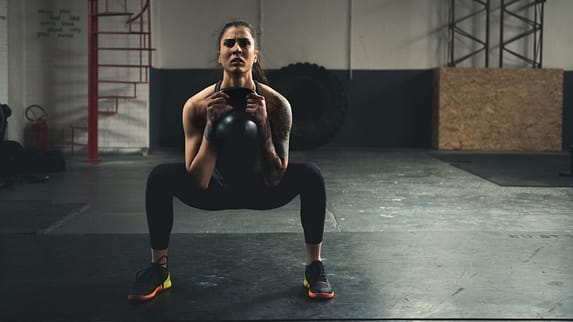Table of Contents
Toggle1. Bodyweight Squats

Bodyweight squats are a fundamental exercise that engages your quads, hamstrings, glutes, and core. Stand with feet shoulder-width apart, lower your body by bending your knees and hips, keeping your back straight, and then return to the starting position.
2. Goblet Squats

Hold a kettlebell or a dumbbell close to your chest while performing squats. This variation helps in maintaining an upright posture and enhances the engagement of your core.
3. Bulgarian Split Squats
Using a bench or an elevated surface, stand facing away from it, with one foot raised behind you. Lower your body into a lunge position, ensuring the front knee doesn’t extend beyond the toes. This targets each leg individually, emphasizing balance and stability.
4. Pistol Squats
Pistol squats are a challenging unilateral exercise that involves lowering your body on one leg while keeping the other leg straight in front of you. This move greatly challenges balance and strength.
5. Sumo Squats

Widen your stance with toes pointing outward, and perform squats. Sumo squats emphasize the inner thighs and glutes more than traditional squats.
6. Front Squats
Hold a barbell across the front of your shoulders, keeping elbows high. This variation shifts the emphasis slightly from the back to the front of your legs and places more demand on your core for stability.
7. Overhead Squats
Using a barbell or a broomstick held overhead, perform squats. This version enhances shoulder mobility and engages your core and stabilizing muscles.

Remember, maintaining proper form is crucial to prevent injury. Start with bodyweight squats if you’re a beginner and gradually progress to weighted squats as you become more comfortable. It’s also beneficial to include a mix of these squat variations to target various muscles and prevent plateauing.
Incorporating these squat variations into your home gym routine can help you build lower body strength, improve muscle tone, and enhance overall stability and balance.
Let’s delve deeper into the world of squats and how they can elevate your home gym workouts!
Benefits of Squats
Strength and Muscle Development
Squats are a compound exercise, meaning they work multiple muscle groups simultaneously. They primarily target the quadriceps, hamstrings, glutes, and lower back muscles, aiding in overall lower body strength and muscle development.
Functional Movement
These exercises mimic everyday movements like sitting, standing, and bending. Mastering squats can improve your ability to perform these actions efficiently and safely.
Core Engagement
While primarily a lower body exercise, squats engage the core muscles to stabilize the body throughout the movement, promoting core strength and stability.
Improved Flexibility and Mobility
Regularly performing squats can increase flexibility in the hips, knees, and ankles, enhancing overall mobility and reducing the risk of injury during daily activities.
Key Tips for Effective Squatting at Home
Form Over Weight: Focus on maintaining proper form rather than lifting heavy weights. This reduces the risk of injury and ensures maximum effectiveness.
Gradual Progression: Start with bodyweight squats and gradually add resistance using dumbbells, kettlebells, or a barbell as you become more comfortable with the movement.
Mind-Muscle Connection: Concentrate on engaging the targeted muscles throughout the movement. Visualize the muscles you’re working to maximize their activation.
Warm-up and Cool Down: Prioritize warming up before squatting to prepare your muscles and joints. Follow it up with stretches to cool down and enhance flexibility.
Consistency is Key: Aim for consistency in your squat routine. Regular practice yields better results than sporadic intense workouts.
Choosing the Right Squat Variation for You
Consider your fitness level, any pre-existing injuries, and your overall fitness goals when selecting squat variations. Beginners might start with bodyweight squats and progress to more challenging variations gradually. For those with knee or back issues, consulting a fitness professional or physical therapist can help identify safer variations.
By incorporating a variety of squats into your home gym routine, you’ll not only strengthen and tone your lower body but also enhance your overall functional fitness. Remember, it’s essential to listen to your body and progress at a pace that feels comfortable for you.
Resources:
Bodybuilding.com – Squat Variations
Comparison tabular
| Squat Variation | Muscles Targeted | Equipment | Difficulty | Key Benefits |
|---|---|---|---|---|
| Bodyweight Squats | Quadriceps, Hamstrings, Glutes, Core | None | Beginner | Fundamental, Improves Range of Motion |
| Goblet Squats | Quadriceps, Hamstrings, Glutes, Core | Dumbbell/Kettlebell | Beginner/Intermediate | Core Engagement, Upright Posture |
| Bulgarian Split Squats | Quadriceps, Hamstrings, Glutes, Core | Bench/Chair | Intermediate | Unilateral, Improved Balance and Stability |
| Pistol Squats | Quadriceps, Hamstrings, Glutes, Core | None (Bodyweight) | Advanced | Unilateral, Balance, and Strength Challenge |
| Sumo Squats | Inner Thighs, Glutes, Quadriceps | Dumbbell/Barbell | Beginner/Intermediate | Emphasizes Inner Thighs, Wider Stance |
| Front Squats | Quadriceps, Hamstrings, Glutes, Core | Barbell | Intermediate | Shifted Emphasis to Front Legs, Core Engagement |
| Overhead Squats | Full Body Engagement | Barbell/Broomstick | Advanced | Enhances Shoulder Mobility, Core and Stabilizer Activation |
This table provides an overview of each squat variation, including the targeted muscles, required equipment, difficulty level, and key benefits associated with each exercise. Depending on your fitness level, equipment availability, and specific goals, you can choose the squat variations that best suit your needs.
Remember, while this table offers a comparative view, the effectiveness of each exercise can vary based on individual factors like form, consistency, and personal fitness levels. Always prioritize proper form and safety during any exercise routine.
Wrapping up
As you venture into your home gym journey, remember that squats are a fantastic compound exercise offering a multitude of benefits. Whether you’re aiming to build strength, enhance muscle tone, or improve functional movement, incorporating various squat variations into your routine can be immensely beneficial.
Starting with bodyweight squats and gradually progressing to more challenging variations allows you to develop proper form and build strength progressively. Consistency and patience are key; don’t rush the process, and listen to your body’s cues.
Tailor your squat routine to fit your fitness level, goals, and equipment availability. And always prioritize safety and proper form over the amount of weight lifted. If you’re ever unsure or have specific concerns, seeking guidance from a fitness professional or physical therapist can be immensely valuable.
So, lace up your workout shoes, find your comfortable squat stance, and embrace the rewarding journey of squatting your way to a stronger, more resilient body in the comfort of your home gym. Cheers to your fitness endeavors.

Hey there, it’s Mike Rrsq, the Editor-in-Chief over at Jsquat.com, and I’m absolutely obsessed with all things squat fitness! I’ve been lucky enough to get some serious recognition for my work in this field. With a solid background in the fitness and wellness industry, I’ve been there right from the get-go, helping shape this website into what it is today.
You see, I’m not just the boss around here; I’m also a passionate contributor. I love sharing my insights through my articles, and trust me, they’re not your run-of-the-mill stuff. Each piece I write is a labor of love, filled with my expertise and real-world experience in the fitness universe. So, if you’re into fitness and looking for some inspiration, you’re in the right place!
Related Posts
- The best 2 effective squat variations to target calves in 21-year-old males at home.
When it comes to targeting calves at home, there are specific squat variations that 21-year-old…
- Best 3 most effective squat variations you need for targeting the adductor magnus.
Squat is one of the most effective exercises that you can do to target quads…
- The Top 4 Effective Squat Variations for targeting your calf muscles at home
Targeting your calf muscles at home is totally doable! Let's delve into a variety of…
- The Best 3 Most Effective Squat variations for targeting the obliques.
Squats are renowned for their ability to strengthen and tone the lower body, but did…
- The Top 3 Effective Squat Variations you need for better swimming performance.
Swimming is an intricate sport that demands a blend of strength, endurance, and technique. While…
- The best 5 most effective squat variations you need for better basketball performance
Basketball demands a unique blend of strength, agility, and explosive power. Choosing the right squat…
- The best 3 most effective squat variations you need for better soccer performance.
Squats are a foundational exercise for athletes across various sports, and for soccer players, they…
- The top 3 effective squat Variations 19-year-old males need to build explosive strength
Squats are foundational exercises for enhancing lower body strength and power. For a 19-year-old male…

